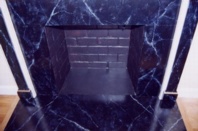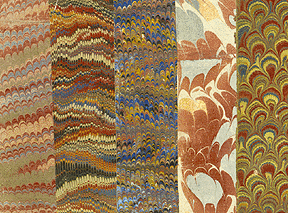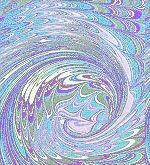

 marbling - Mottling or streaking that resembles the veined texture
of marble. To mottle or streak with
colors and veins using painting
techniques to simulate
the appearance of marble. Such painting on hard surfaces,
such as furniture
and architecture is sometimes
called faux-marble. It
is frequently employed where the price
or weight of authentic
marble is prohibitive.
marbling - Mottling or streaking that resembles the veined texture
of marble. To mottle or streak with
colors and veins using painting
techniques to simulate
the appearance of marble. Such painting on hard surfaces,
such as furniture
and architecture is sometimes
called faux-marble. It
is frequently employed where the price
or weight of authentic
marble is prohibitive.
Faux-stone

 fresco painting
was widely used in Pompeii, in a style
called incrustation. The
craft was revived in Europe during
the Renaissance
with two schools of faux
marbling developing.
fresco painting
was widely used in Pompeii, in a style
called incrustation. The
craft was revived in Europe during
the Renaissance
with two schools of faux
marbling developing.  The Italian school
was loose and expressive,
while the French school was formal
and realistic. It took most apprentices ten years or more
to fully master the art.
The most recent revival of faux-marbling started in the 1980s.
Some advice on how to do faux-marbling can be found at the end
of this article.
The Italian school
was loose and expressive,
while the French school was formal
and realistic. It took most apprentices ten years or more
to fully master the art.
The most recent revival of faux-marbling started in the 1980s.
Some advice on how to do faux-marbling can be found at the end
of this article.
"Marbling" can also
refer to the application of oil
paints floated on water onto paper.
Marbled paper was commonly used as endpapers in books
bound in the nineteenth century.
Examples of marbled paper:
Charles W. Woolnough (British, n.d.), Author;
London: G. Bell, 1881, Publisher, The Whole Art of Marbling as Applied to Paper,
Book Edges, etc. Containing a full Description  of the Nature and Properties of the Materials
Used, the Method of Preparing Them, and of Executing Every Kind
of Marbling in Use at the Present Time, 1881, printed
book; 82 p. : 5 ill. , 31 [i.e.
39] , col. pl. (part mounted) ; 21 cm, Metropolitan Museum of
Art, NY.
of the Nature and Properties of the Materials
Used, the Method of Preparing Them, and of Executing Every Kind
of Marbling in Use at the Present Time, 1881, printed
book; 82 p. : 5 ill. , 31 [i.e.
39] , col. pl. (part mounted) ; 21 cm, Metropolitan Museum of
Art, NY.
 Illustrated:
Progressive stages of Spanish marbling, from The Whole
Art of Marbling. (pages 48-49)
Illustrated:
Progressive stages of Spanish marbling, from The Whole
Art of Marbling. (pages 48-49)



 Five marbled papers with combed patterns, created
by moving various rakes or combs through colors that are applied
over an uncombed "stone" pattern. Here are five contemporary Italian marbled papers
for which no comb was used, making them look more like natural
marbles. And here are six
contemporary marbled papers from Thailand.
Five marbled papers with combed patterns, created
by moving various rakes or combs through colors that are applied
over an uncombed "stone" pattern. Here are five contemporary Italian marbled papers
for which no comb was used, making them look more like natural
marbles. And here are six
contemporary marbled papers from Thailand.

Professional faux-marblers use
a variety of techniques to closely imitate real marbles. Amateurs
should be content simply to suggest the appearance
of marble rather than accurately represent
a particular stone. It is quite possible for a beginner to produce
a pleasing effect with a little practice. using scumbling,
sponging and feather-streaking
techniques on a gessoed and
painted surface.
How to paint faux marble:
Materials:
- White oil-based eggshell paint
-- sometimes known as semigloss of softsheen.
- Boiled linseed
oil -- available at a hardware or paint store. It is used
to slow the paint drying time.
- Turpentine or mineral
spirits -- to thin the paint and clean
the brushes.
- A tube of black artist oil paint
-- one tube of "lamp black" can be plenty, even for
a fairly large area.
- Brushes
-- one of which should be good quality
and very sof.
- Two feathers
-- goose feathers are the traditional
favorite, but any large feather will do.
- Some rags or lint-free cloths.
Procedure:
- Obtain some good photos (if
not actual pieces) of the sorts of marble you'd like to emulate.
Google Images displays p ictures of some found on the Internet.
These will give you a better understanding of how to use the
techniqes described below.

- Clean the surface
well, then cover it with eggshell paint and let it dry overnight.
The following day, paint the surface with a thin coat
of linseed oil. This slows
the drying time of the paint considerably and keeps it workable.
Next mix the black oil paint with a little of the white eggshell
to produce a light gray. Scatter texturing passages
of this over the linseed oil base. Use other shades of gray to
fill in gaps so there is a swirly design of color.
- Use a soft, dry paintbrush (two
or three inches wide) to blend the color. Dab a rag over the
surface to break up the color and remove excess paint, then blur
the surface again with the dry brush.
- Use a thinner brush to add passages
of light veining in a middle-value
gray. Veins should not cross one another, neither starting nor
stopping suddenly, nor should they ever radiate
from any point. They must
progress in what appear to be random diagonal
directions, never straight
or otherwise predictable ones. If required, color
can be removed from part of the surface by dipping a brush in
mineral spirits, and lifting
the color off with the brush. Then thoroughly scumble
the whole surface with a dry brush, a natural sponge or a crumpled
cloth.
- Add fine veining with a feather. Dip the feather in mineral
spirits and roughly brush backwards to separate the barbs. Then
add fine wiggly veins by brushing them in with dark
gray paint. Use a feather to add light
colored veins after dipping it into off-white paint or after
into mineral spirits. If you use mineral spirits, a light vein
will appear when you drag the feather, by dissolving the uppermost
layer of paint. Finally, unify
the whole suface by gently scumbling it again with a very soft
brush -- badger hair brushes are traditionally
favored.
Also see eyedropper
and ox gall.

https://inform.quest/_art

 marbling - Mottling or streaking that resembles the veined texture
of marble. To mottle or streak with
colors and veins using painting
techniques to simulate
the appearance of marble. Such painting on hard surfaces,
such as furniture
and architecture is sometimes
called faux-marble. It
is frequently employed where the price
or weight of authentic
marble is prohibitive.
marbling - Mottling or streaking that resembles the veined texture
of marble. To mottle or streak with
colors and veins using painting
techniques to simulate
the appearance of marble. Such painting on hard surfaces,
such as furniture
and architecture is sometimes
called faux-marble. It
is frequently employed where the price
or weight of authentic
marble is prohibitive.

 fresco painting
was widely used in Pompeii, in a style
called incrustation. The
craft was revived in Europe during
the Renaissance
with two schools of faux
marbling developing.
fresco painting
was widely used in Pompeii, in a style
called incrustation. The
craft was revived in Europe during
the Renaissance
with two schools of faux
marbling developing.  The Italian school
was loose and expressive,
while the French school was formal
and realistic. It took most apprentices ten years or more
to fully master the art.
The most recent revival of faux-marbling started in the 1980s.
Some advice on how to do faux-marbling can be found at the end
of this article.
The Italian school
was loose and expressive,
while the French school was formal
and realistic. It took most apprentices ten years or more
to fully master the art.
The most recent revival of faux-marbling started in the 1980s.
Some advice on how to do faux-marbling can be found at the end
of this article. of the Nature and Properties of the Materials
Used, the Method of Preparing Them, and of Executing Every Kind
of Marbling in Use at the Present Time, 1881, printed
book; 82 p. : 5 ill. , 31 [i.e.
39] , col. pl. (part mounted) ; 21 cm, Metropolitan Museum of
Art, NY.
of the Nature and Properties of the Materials
Used, the Method of Preparing Them, and of Executing Every Kind
of Marbling in Use at the Present Time, 1881, printed
book; 82 p. : 5 ill. , 31 [i.e.
39] , col. pl. (part mounted) ; 21 cm, Metropolitan Museum of
Art, NY.Illustrated:
Progressive stages of Spanish marbling, from The Whole
Art of Marbling. (pages 48-49)


![]()
Five marbled papers with combed patterns, created
by moving various rakes or combs through colors that are applied
over an uncombed "stone" pattern. Here are five contemporary Italian marbled papers
for which no comb was used, making them look more like natural
marbles. And here are six
contemporary marbled papers from Thailand.